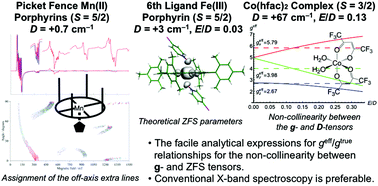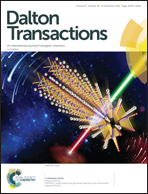ESR analyses of picket fence MnII and 6th ligand coordinated FeIII porphyrins (S = 5/2) and a CoII(hfac) complex (S = 3/2) with sizable ZFS parameters revisited: a full spin Hamiltonian approach and quantum chemical calculations†
Abstract
The fictitious spin-1/2 (effective spin-1/2) Hamiltonian approach has been the putative method to analyze the conventional fine-structure/hyperfine ESR spectra of high spin metallocomplexes with sizable zero-field splitting (ZFS) tensors since the early 1950s, and the approach gives salient principal geff-values far from g = 2 without explicitly affording their ZFS values in most cases. The experimental geff-values thus determined, however, never agree with those (gtrue-values) of the true principal g-tensors, which are obtainable from reliable quantum chemical calculations. We have recently derived exact or extremely accurate analytical expressions for the geff/gtrue relationships for the spin quantum number S's up to S = 7/2 (T. Yamane et al., Phys. Chem. Chem. Phys., 2017, 19, 24769–24791). In this work, we have removed the limitation of the collinearity between g- and ZFS tensors and derived the generalized geff/gtrue relationships. To illustrate the usefulness of the present approach, we have revisited important typical high spin systems with large ZFS values such as picket fence metalloporphyrins with MnII (S = 5/2) (Q. Yu et al., Dalton Trans., 2015, 44, 9382–9390), a 6th ligand coordinated porphyrin with FeIII (S = 5/2) (Y. Ide et al., Dalton Trans., 2017, 46, 242–249) and a pseudo-octahedral CoII (S = 3/2)(hfac)2 complex (D. V. Korchagin et al., Dalton Trans., 2017, 46, 7540–7548), completing the ESR spectral and magnetic susceptibility analyses and gaining significant physical insights into their electronic structures. The off-principal axis extra peaks overlooked in the documented spectra of the picket fence MnII porphyrins have fully been assigned, affording their accurate true g-, hyperfine and ZFS tensors, for the first time. For the CoII complex, the occurrence of the non-collinearity between the g- and ZFS tensors has been discussed by using the generalized geff/gtrue relationships. We have attempted to carry out reliable DFT-based and ab initio quantum chemical calculations of their magnetic tensors, in which spin–orbit couplings are incorporated, reproducing the experimental true tensors. We emphasize that the incorporation of multi-reference nature in the electron configuration is important to interpret the magnetic tensors for the CoII complex.



 Please wait while we load your content...
Please wait while we load your content...